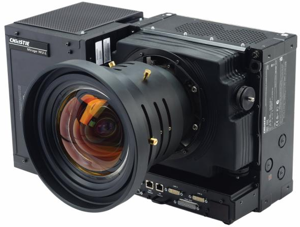Christie Rolls Out Bulbless Projector

The bulbless Mirage WU-L uses a sealed solid state LED illumination unit to provide a brightness of 600 lumens and 1,920 x 1,200 native resolution. |
Christie, a company involved in projection technologies since 1926, has released a bulbless 3D ready DLP projector that offers 60,000 hours of operation without the need for maintenance.
In place of a bulb the new projector, dubbed the Mirage WU-L, uses a sealed solid state LED illumination unit that works in conjunction with a 1-chip DLP engine to provide a dynamic contrast ratio of 10,000:1, a brightness of 600 lumens, and a native resolution of 1,920 x 1,200 (WUXGA).
In addition to low energy consumption and low levels of heat dissipation common to solid state LED technologies, the new illumination unit also offers a sealed design that allows the projector to function without an air filter.
Visual features of the projector include ArrayLOC, an ability that dynamically synchronizes color and brightness levels when the projector combines its image with the images of other projectors in an array, and Christie Twist, an ability that allows multiple projectors to display a single blended image on curved, irregular surfaces.
The Mirage WU-L ships with an adjustable lens mount that accommodates a total of three lenses: a fixed 0.64:1 lens, a fixed 0.75:1 lens, and a 1.2:1 to 1.6:1 zoom lens. Mechanical lens shift capabilities for the 0.64:1 fixed lens include a ±5 percent vertical shift and a ±5 percent horizontal shift, while both the 0.75:1 fixed lens and the zoom lens can be adjusted ±75 percent horizontally or ±100 percent vertically.
For connectivity and control the Mirage WU-L ships with RS-232 control, Ethernet support, and the ability to accept incoming control signals through the RS-422 standard.
Other features include a dual input 3D mode with passive to active conversion and USB support.
AV ports include HDMI, DVI/DVI-D/DVI-I, 5BNC, analog RGB/component (mini D-sub 15-pin), USB, and HD-SDI. Control ports include RS232, RJ-45, and RS422.
Dual HD-SDI input cards, Twin HDMI input cards, Dual Link DVI input cards, Rugged Motion Platform kits, and user kits that include both wired and IR remotes are available as optional accessories.
The Mirage WU-L is currently available and ships with a three year parts and labor warranty.
Further information can be found here.
About the Author
Dan Thompson is a freelance writer based in Brea, CA. He can be reached here.